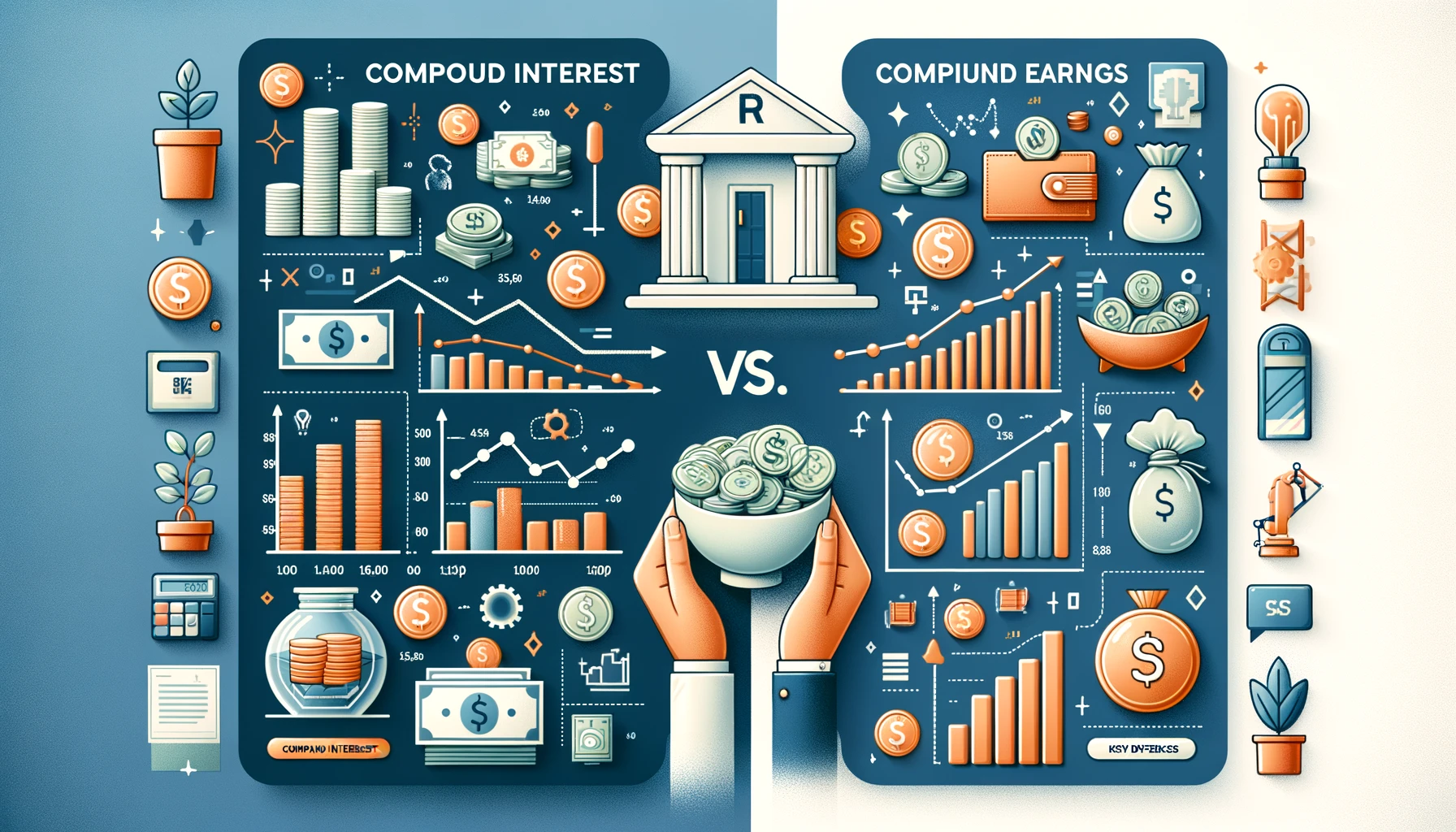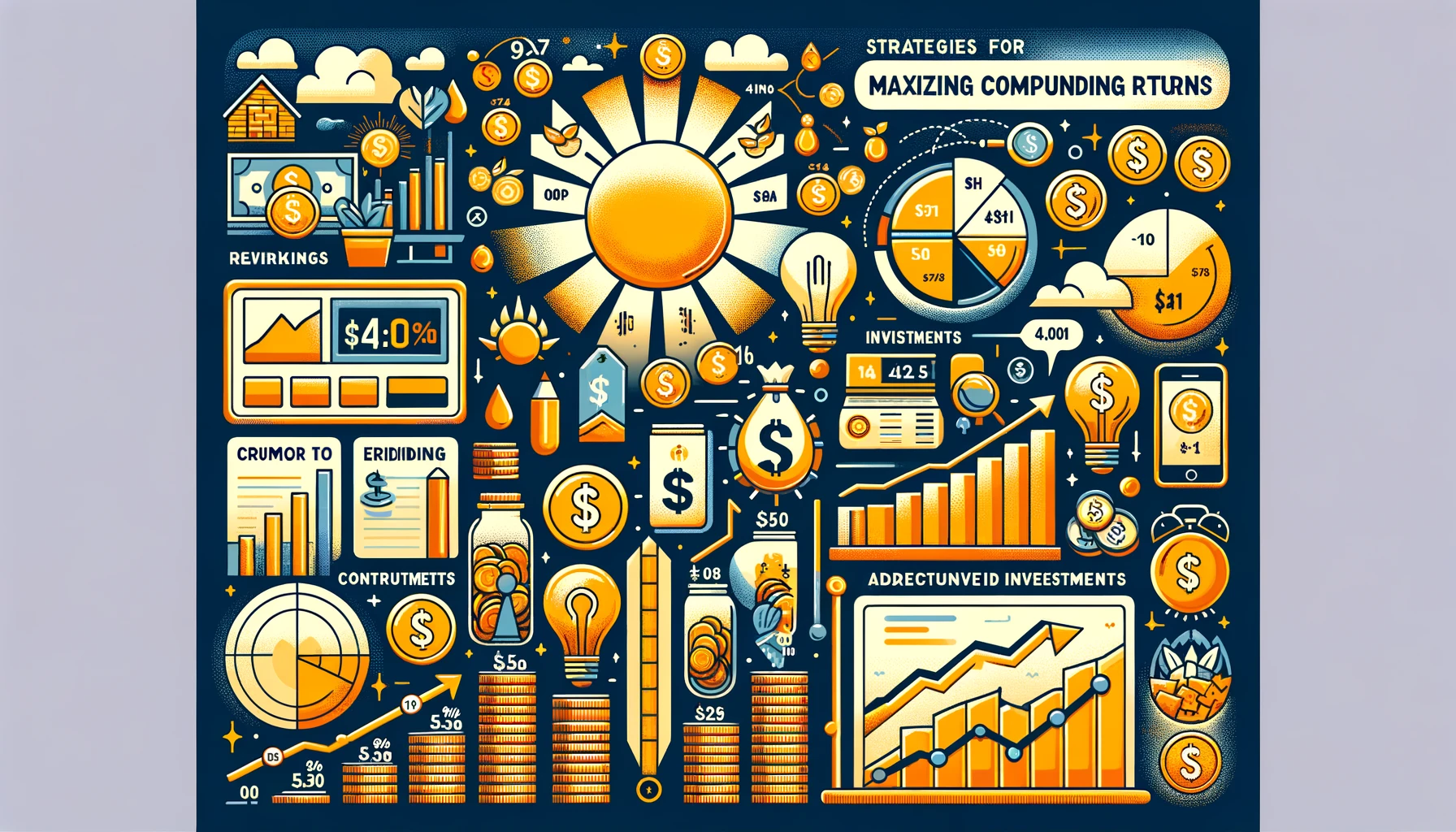Compound Interest or Compound Earnings
In the world of personal finance and investment, two terms often surface, creating a mix of intrigue and confusion: compound interest and compound earnings.
While they share a common root in the principle of compounding, their application and impact on investments can vary significantly.
Compound interest is a familiar concept to many, often associated with savings accounts and bonds, where it plays a crucial role in growing wealth over time.
On the other hand, compound earnings are more closely related to investments like stocks and mutual funds, where they contribute to the accumulation of wealth through reinvested dividends and capital gains.
Understanding these concepts is not just academic; it's a practical necessity for anyone looking to navigate the investment landscape effectively. Whether you are a novice investor starting your journey or a seasoned player in the market, grasping the distinction between compound interest and compound earnings is essential.
This article aims to demystify these terms, particularly focusing on their roles and differences in the context of stocks and mutual funds. By the end of this exploration, readers will have a clearer understanding, enabling them to make more informed decisions in their investment ventures.
Fundamentals of Compounding

In financial terms, compounding refers to the process where the value of an investment grows exponentially over time, as the earnings from that investment, be it interest or dividends, themselves earn additional earnings.
This concept is succinctly captured in Albert Einstein's description of compound interest as "the eighth wonder of the world." He recognized that those who understand it, earn it; those who don't, pay it.
The general principle of compounding applies universally across various types of investments. In a savings account, for instance, compound interest accumulates when the interest earned is added to the principal, and in subsequent periods, interest is earned on this new, larger amount.
In the context of stocks and mutual funds, compounding manifests through the reinvestment of dividends and capital gains, allowing for the purchase of more shares, which further increases future potential earnings. This principle of compounding can significantly affect the growth trajectory of an investment, particularly over a long period.
For a deeper understanding of compounding and its miraculous effects on investments, the Investopedia article on compound interest offers a comprehensive overview. Additionally, the Securities and Exchange Commission's introduction to compound interest provides valuable insights into how compounding works and its importance in investment strategies.
By grasping these fundamental concepts, investors can better appreciate the nuances of compound interest and compound earnings, setting the stage for a more detailed exploration of their differences and applications in various investment vehicles.
Understanding Compound Interest

Definition of Compound Interest:
Compound interest is the interest calculated on the initial principal and also on the accumulated interest of previous periods. It can be thought of as “interest on interest,” allowing a sum to grow at a faster rate than simple interest, which is calculated only on the principal amount.
How Compound Interest Works:
The formula for calculating compound interest is A = P(1 + r/n)^(nt), where:
- A is the amount of money accumulated after n years, including interest.
- P is the principal amount.
- r is the annual interest rate (decimal).
- n is the number of times that interest is compounded per year.
- t is the time the money is invested for in years.
This formula demonstrates how compound interest grows the principal amount over each compounding period, whether that's annually, quarterly, monthly, or daily.
Examples of Investment Vehicles with Compound Interest:
- Savings Accounts: Many savings accounts compound interest daily or monthly.
- Fixed Deposits: These usually offer compound interest at monthly, quarterly, or yearly intervals.
- Bonds: Certain types of bonds may also compound interest at regular intervals.
For a practical understanding, Bankrate’s Compound Interest Calculator provides a user-friendly tool for seeing how compound interest works over different periods.
Exploring Compound Earnings

Definition of Compound Earnings:
Compound earnings refer to the earnings generated on an investment due to the reinvestment of dividends (for stocks) or interest (for bonds and other fixed-income securities). It’s the process of earning returns not only on the initial principal but also on the accumulated earnings from previous periods.
How Compound Earnings Work:
In the context of stocks and mutual funds, compound earnings occur when dividends or capital gains are reinvested to purchase additional shares, which then potentially generate more dividends. This reinvestment cycle leads to exponential growth in the value of the investment.
Role of Reinvestment in Compound Earnings:
Reinvesting dividends is a key factor in realizing compound earnings. For example, if a stock pays dividends, those dividends can be used to buy more shares of the stock. Over time, as the number of shares increases, so does the potential dividend income, assuming the dividend per share remains constant or increases.
Compound Interest vs. Compound Earnings: Key Differences

Comparison and Contrast:
- Nature of Returns: Compound interest primarily relates to the interest earned on cash deposits or fixed-income investments. Compound earnings, however, are more relevant to variable-income investments like stocks and mutual funds.
- Calculation Methods: The calculation of compound interest is typically straightforward and based on a fixed rate, whereas compound earnings involve variable factors like fluctuating dividend yields and share prices.
- Investment Vehicles: Compound interest is common in savings accounts, CDs, and bonds. Compound earnings are seen in stocks, mutual funds, and ETFs that pay dividends.
Impact on Returns:
- Predictability: Compound interest offers more predictability and less risk, but potentially lower returns compared to compound earnings, which can offer higher returns due to the potential growth in stock value and dividends but with higher risk and variability.
For a more detailed comparison, The Balance offers an insightful article on how compound interest works in various investment scenarios. Understanding these differences is crucial for investors in aligning their investment strategies with their financial goals and risk tolerance.
Compounding in Stocks and Mutual Funds

How Compounding Works in Stocks and Mutual Funds:
In the realm of stocks and mutual funds, compounding occurs when the earnings from an investment, such as dividends or capital gains, are reinvested to purchase more shares. Over time, these additional shares can generate their own earnings, leading to a snowball effect on the investment’s growth.
Reinvested Dividends and Capital Gains Distributions:
- Dividends: When dividends from stocks or mutual funds are reinvested, they buy more shares of the stock or fund. As a result, future dividends can be based on a larger number of shares, potentially increasing the total dividend income.
- Capital Gains: For mutual funds, capital gains distributions can also be reinvested to buy more shares, similarly enhancing the potential for growth.
Effect on Investment Portfolio Growth:
Compounding in stocks and mutual funds can significantly accelerate the growth of an investment portfolio. This is particularly evident over long periods, where the effects of reinvesting earnings compound, leading to exponential growth.
For an in-depth understanding, Morningstar’s analysis on the power of compounding in mutual funds offers valuable insights.
Examples and Case Studies

Real-Life Examples of Compound Interest and Compound Earnings:
- Compound Interest Example: A savings account with a $10,000 initial deposit and an annual interest rate of 3% compounded monthly. Over 20 years, the account would grow significantly more than with simple interest.
- Compound Earnings Example: An investor buys shares of a dividend-paying stock or mutual fund. By reinvesting the dividends to purchase additional shares, the total investment value grows as the number of shares increases over time.
Graphical Representations:
Graphs can effectively illustrate the difference in growth between investments with compound interest and those with compound earnings. For example, a line graph showing the growth of a fixed deposit with compound interest versus a dividend-reinvesting mutual fund over 20 years can be illuminating.
A practical tool for visualizing these differences is the Compound Interest Calculator from Investor.gov, which can model the growth of investments with different compounding frequencies.
Understanding these examples and visualizing the impact through graphs can provide a clearer picture of how compound interest and compound earnings operate, helping investors make more informed decisions about their investment strategies.
Strategies for Maximizing Compounding Returns

Effectively Utilizing Compound Interest and Compound Earnings:
- Start Early: The sooner you start investing, the more time your money has to compound.
- Reinvest Earnings: In stocks and mutual funds, opt for dividend reinvestment plans (DRIPs) to purchase additional shares.
- Regular Contributions: Consistently adding to your investments can significantly boost the compounding effect, especially in interest-bearing accounts or dividend-paying stocks.
- Choose the Right Vehicle: Select investment vehicles based on your financial goals and the compounding benefits they offer.
- Monitor and Adjust: Regularly review your investment portfolio to ensure it aligns with your goals, adjusting to more favorably compounding options as needed.
Factors in Choosing Investment Vehicles:

- Risk Tolerance: Higher potential returns with compound earnings (stocks, mutual funds) usually come with higher risk.
- Investment Horizon: Longer horizons favor compounding; thus, younger investors might lean more towards stocks for compound earnings.
- Liquidity Needs: Savings accounts offer more liquidity but lower returns compared to stocks.
For more strategies on maximizing compounding returns, The Balance offers practical advice that can guide investment decisions.
Conclusion

Key Takeaways About Compound Interest and Compound Earnings:
- Compound interest, commonly found in savings and fixed-income investments, grows an investment through interest on interest.
- Compound earnings in stocks and mutual funds come from reinvesting dividends and capital gains, potentially leading to exponential portfolio growth.
- Understanding these concepts is vital for investors to make the most of their investments and align strategies with financial goals.
The Importance of Understanding These Concepts:
Grasping the intricacies of compound interest and compound earnings is essential for making informed, strategic investment decisions. It empowers investors to choose the right vehicles and strategies to maximize their financial growth and achieve their long-term objectives.
Further Resources
Books and Websites for More Information:
- "The Intelligent Investor" by Benjamin Graham for investment principles.
- "A Random Walk Down Wall Street" by Burton Malkiel for understanding market behavior.
- Investopedia and Morningstar for in-depth financial insights and analysis.
Financial Advisors and Investment Professionals:
- For personalized advice, consult a Certified Financial Planner (CFP) through the CFP Board.
- The Financial Planning Association offers resources for finding qualified financial advisors.
By utilizing these resources and strategies, investors can harness the power of compounding to its fullest potential, paving the way for a more secure and prosperous financial future.



